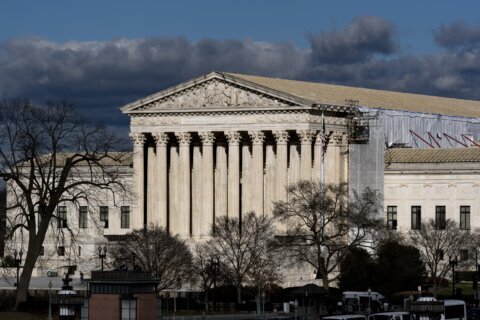WASHINGTON (AP) — The Supreme Court on Wednesday threw out Wisconsin state legislative maps that were preferred by the state’s Democratic governor and selected by Wisconsin’s top court, a win for Republicans that also makes it unclear what the boundaries will be for the fall election.
But while the justices in an unsigned opinion threw out voting maps the Wisconsin Supreme Court had selected for the State Assembly and Senate, they left in place state congressional maps. The state’s highest court selected the maps from a range of options after the Republican-controlled Legislature and the governor couldn’t agree.
The U.S. Supreme Court has signaled it may significantly change the ground rules that govern redistricting. Last month it stopped a ruling by a panel of federal judges requiring Alabama to redraw its maps to give African-Americans a better shot at selecting their representatives, saying it may need to revise the longstanding case law that governs that. It’s that case law that the high court referred to in the Wisconsin ruling.
The court declined to overrule state supreme courts in North Carolina and Pennsylvania to block the maps those bodies ordered be implemented in 2022, but four conservative justices wrote that they want to rule on the novel legal theory that state legislatures, rather than state courts, have supreme power in drawing maps. The involvement of the high court comes after its 2019 ruling that federal courts have no role in stopping partisan gerrymandering.
Its ruling in the Wisconsin case marks the first time this redistricting cycle that the high court has overturned maps drawn by a state.
Wisconsin Republicans had complained that Gov. Tony Evers’ maps moved too many people to increase the number of Assembly districts with a majority of Black and Hispanic voters from six to seven in violation of the federal Voting Rights Act.
The Wisconsin Supreme Court ruled 4-3 in favor of adopting Evers’ maps earlier this month, with a conservative justice joining three liberals in the majority. Republicans immediately appealed to the U.S. Supreme Court, arguing that the maps drawn by Evers were racially gerrymandered.
The Wisconsin Supreme Court failed to consider whether a “race-neutral alternative that did not add a seventh majority-black district would deny black voters equal political opportunity,” the Supreme Court said. The analysis done by the Wisconsin Supreme Court did not adhere to U.S. Supreme Court precedents “and its judgment cannot stand,” the nation’s high court said.
The justices sent the case back to the Wisconsin Supreme Court, saying it is “free to take additional evidence if it prefers to reconsider the Governor’s maps rather than choose from among the other submissions.” They said their action would give Wisconsin’s high court “sufficient time to adopt maps” in time for the state’s Aug. 9 primary.
The decision throws into question whether candidates will be able to begin circulating nomination papers as scheduled on April 15 given that new district boundaries aren’t set.
Two justices, Sonia Sotomayor and Elena Kagan, said they disagreed with their colleagues’ decision.
“I would allow that process to unfold, rather than further complicating these proceedings with legal confusion,” Sotomayor wrote.
Redistricting is the process of redrawing the state’s political boundaries based on the latest census, showing how populations have changed in neighborhoods, cities and counties since 2010. Mapmakers can create an advantage for their political party in future elections by packing opponents’ voters into a few districts or spreading them thin among multiple districts — a process known as gerrymandering.
With the stakes so high, Evers and Republican lawmakers couldn’t agree on a plan, leading to both sides asking the state Supreme Court to choose between each side’s maps.
Democrats would have made some marginal gains under Evers’ plan but Republicans would maintain their majorities in the Assembly and Senate, according to an analysis from the governor’s office. Currently, Republicans hold a 61-38 majority in the Assembly and a 21-12 advantage in the Senate.
Republicans were not projected to have a super majority that could override any Evers veto, even under the GOP map that the state Supreme Court rejected.
Republicans currently hold five of the state’s eight congressional districts. The new map upheld by the court would make the southeastern Wisconsin district held by Republican Rep. Bryan Steil more competitive.
Evers said he was confident that the maps he proposed are constitutional and if he has to demonstrate to the Wisconsin Supreme Court again that they’re better than the current maps, he will.
Wisconsin’s Democratic Attorney General Josh Kaul, who defended Evers, called the Supreme Court’s ruling “shocking” and consistent with “increasing activism” from the conservative majority on the court.
“It’s now created massive uncertainty going forward,” Kaul said. “We’re going back to the drawing board on this and I think there’s going to be a lot of litigation ahead.”
___
Associated Press writers David A. Lieb in Jefferson City, Missouri, Nicholas Riccardi in Denver and Todd Richmond contributed to this report. Bauer and Richmond reported from Madison, Wisconsin
Copyright © 2024 The Associated Press. All rights reserved. This material may not be published, broadcast, written or redistributed.







